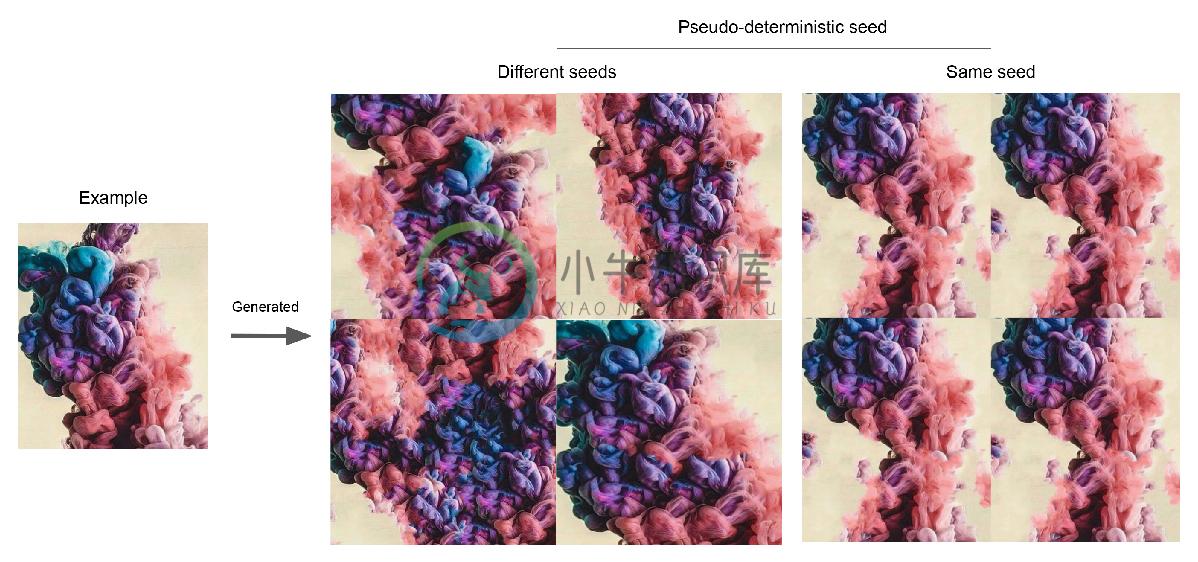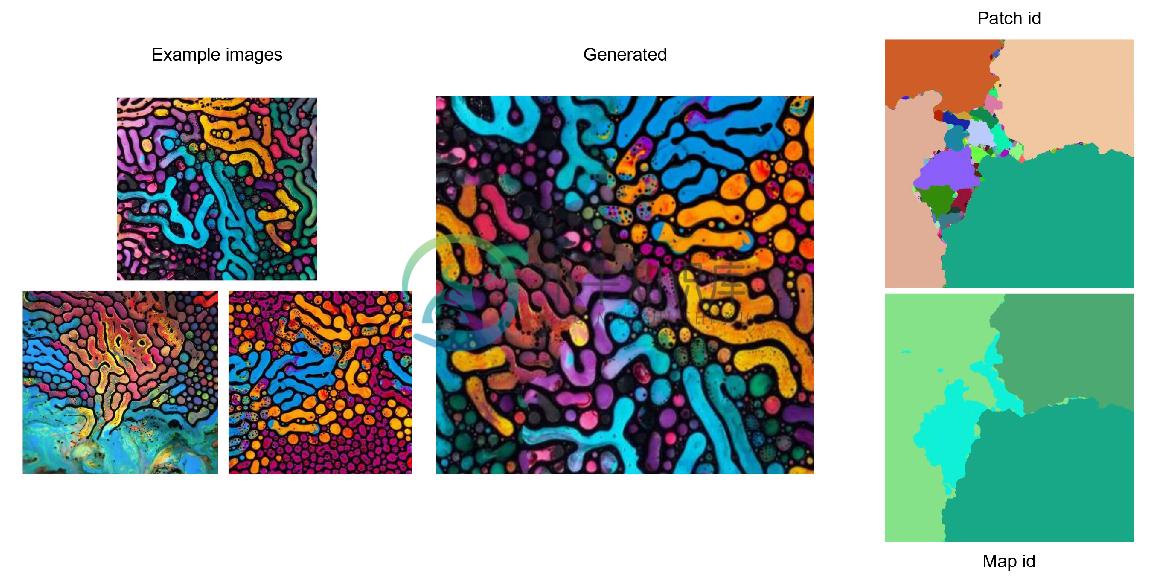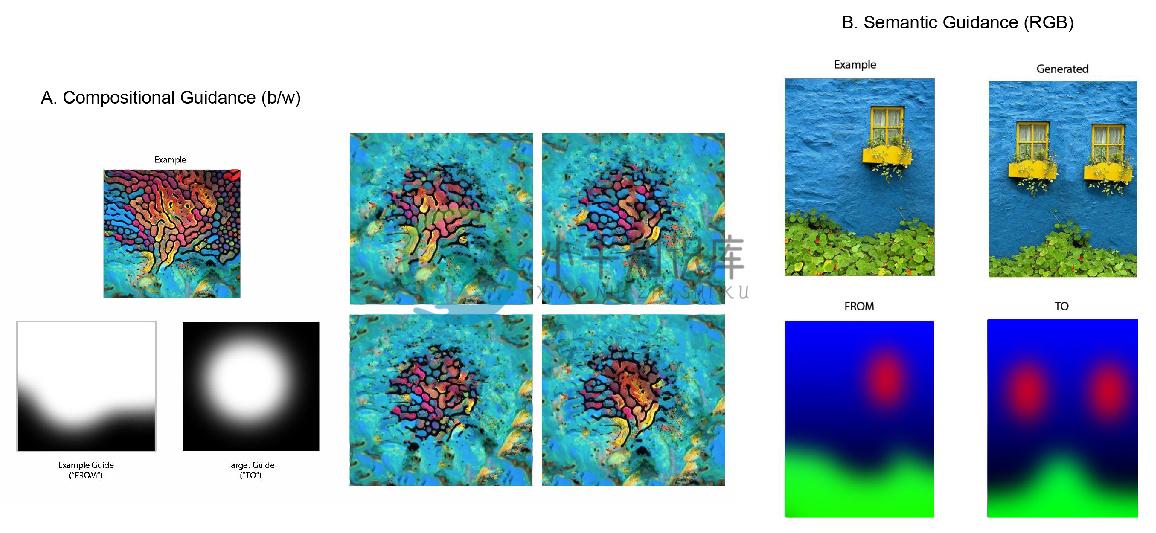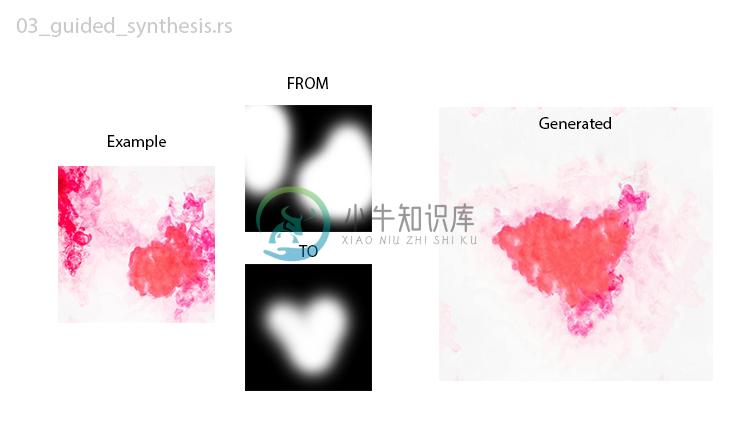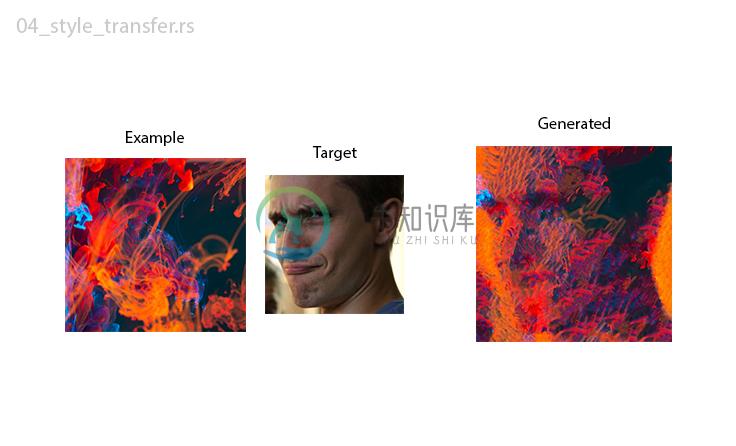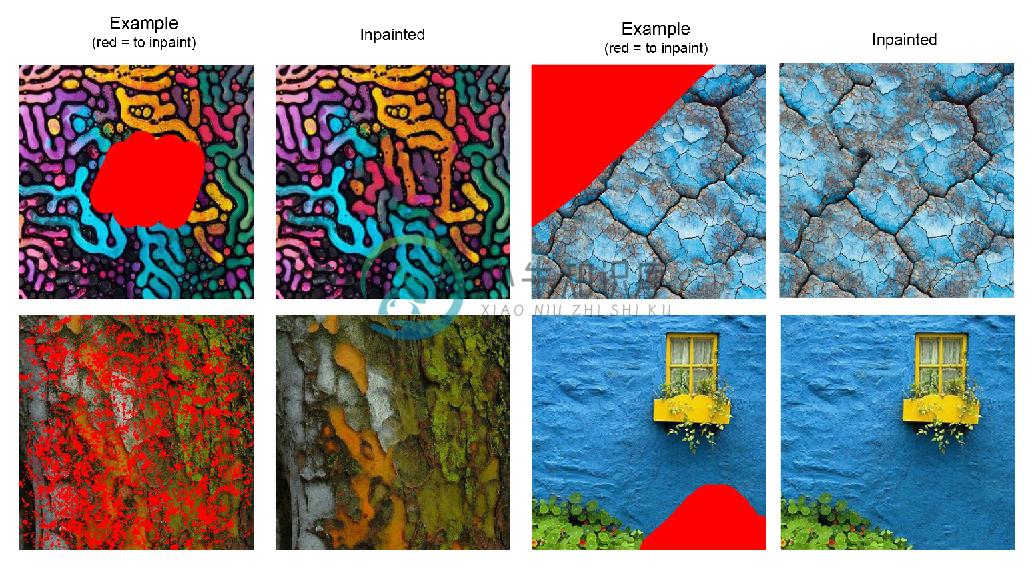��
texture-synthesis
A light Rust API for Multiresolution Stochastic Texture Synthesis [1], a non-parametric example-based algorithm for image generation.
The repo also includes multiple code examples to get you started (along with test images), and you can find a compiled binary with a command line interface under the release tab.
Also see our talk More Like This, Please! Texture Synthesis and Remixing from a Single Example which explains this technique and the background more in-depth:
Features and examples
1. Single example generation
Generate similar-looking images from a single example.
API - 01_single_example_synthesis
use texture_synthesis as ts;
fn main() -> Result<(), ts::Error> {
//create a new session
let texsynth = ts::Session::builder()
//load a single example image
.add_example(&"imgs/1.jpg")
.build()?;
//generate an image
let generated = texsynth.run(None);
//save the image to the disk
generated.save("out/01.jpg")
}
CLI
cargo run --release -- --out out/01.jpg generate imgs/1.jpg
You should get the following result with the images provided in this repo:
2. Multi example generation
We can also provide multiple example images and the algorithm will "remix" them into a new image.
API - 02_multi_example_synthesis
use texture_synthesis as ts;
fn main() -> Result<(), ts::Error> {
// create a new session
let texsynth = ts::Session::builder()
// load multiple example image
.add_examples(&[
&"imgs/multiexample/1.jpg",
&"imgs/multiexample/2.jpg",
&"imgs/multiexample/3.jpg",
&"imgs/multiexample/4.jpg",
])
// we can ensure all of them come with same size
// that is however optional, the generator doesnt care whether all images are same sizes
// however, if you have guides or other additional maps, those have to be same size(s) as corresponding example(s)
.resize_input(ts::Dims {
width: 300,
height: 300,
})
// randomly initialize first 10 pixels
.random_init(10)
.seed(211)
.build()?;
// generate an image
let generated = texsynth.run(None);
// save the image to the disk
generated.save("out/02.jpg")?;
//save debug information to see "remixing" borders of different examples in map_id.jpg
//different colors represent information coming from different maps
generated.save_debug("out/")
}
CLI
cargo run --release -- --rand-init 10 --seed 211 --in-size 300x300 -o out/02.png --debug-out-dir out generate imgs/multiexample/1.jpg imgs/multiexample/2.jpg imgs/multiexample/3.jpg imgs/multiexample/4.jpg
You should get the following result with the images provided in this repo:
3. Guided Synthesis
We can also guide the generation by providing a transformation "FROM"-"TO" in a form of guide maps
API - 03_guided_synthesis
use texture_synthesis as ts;
fn main() -> Result<(), ts::Error> {
let texsynth = ts::Session::builder()
// NOTE: it is important that example(s) and their corresponding guides have same size(s)
// you can ensure that by overwriting the input images sizes with .resize_input()
.add_example(ts::Example::builder(&"imgs/2.jpg").with_guide(&"imgs/masks/2_example.jpg"))
// load target "heart" shape that we would like the generated image to look like
// now the generator will take our target guide into account during synthesis
.load_target_guide(&"imgs/masks/2_target.jpg")
.build()?;
let generated = texsynth.run(None);
// save the image to the disk
generated.save("out/03.jpg")
}
CLI
cargo run --release -- -o out/03.png generate --target-guide imgs/masks/2_target.jpg --guides imgs/masks/2_example.jpg -- imgs/2.jpg
NOTE: Note the use of -- to delimit the path to the example imgs/2.jpg, if you don't specify --, the pathto the example will be used as another guide path and there won't be any examples.
You should get the following result with the images provided in this repo:
4. Style Transfer
Texture synthesis API supports auto-generation of example guide maps, which produces a style transfer-like effect.
API - 04_style_transfer
use texture_synthesis as ts;
fn main() -> Result<(), ts::Error> {
let texsynth = ts::Session::builder()
// load example which will serve as our style, note you can have more than 1!
.add_examples(&[&"imgs/multiexample/4.jpg"])
// load target which will be the content
// with style transfer, we do not need to provide example guides
// they will be auto-generated if none were provided
.load_target_guide(&"imgs/tom.jpg")
.guide_alpha(0.8)
.build()?;
// generate an image that applies 'style' to "tom.jpg"
let generated = texsynth.run(None);
// save the result to the disk
generated.save("out/04.jpg")
}
CLI
cargo run --release -- --alpha 0.8 -o out/04.png transfer-style --style imgs/multiexample/4.jpg --guide imgs/tom.jpg
You should get the following result with the images provided in this repo:
5. Inpaint
We can also fill-in missing information with inpaint. By changing the seed, we will get different version of the 'fillment'.
API - 05_inpaint
use texture_synthesis as ts;
fn main() -> Result<(), ts::Error> {
let texsynth = ts::Session::builder()
// let the generator know which part we would like to fill in
// if we had more examples, they would be additional information
// the generator could use to inpaint
.inpaint_example(
&"imgs/masks/3_inpaint.jpg",
// load a "corrupted" example with missing red information we would like to fill in
ts::Example::builder(&"imgs/3.jpg")
// we would also like to prevent sampling from "corrupted" red areas
// otherwise, generator will treat that those as valid areas it can copy from in the example,
// we could also use SampleMethod::Ignore to ignore the example altogether, but we
// would then need at least 1 other example image to actually source from
// example.set_sample_method(ts::SampleMethod::Ignore);
.set_sample_method(&"imgs/masks/3_inpaint.jpg"),
// Inpaint requires that inputs and outputs be the same size, so it's a required
// parameter that overrides both `resize_input` and `output_size`
ts::Dims::square(400),
)
// Ignored
.resize_input(ts::Dims::square(200))
// Ignored
.output_size(ts::Dims::square(100))
.build()?;
let generated = texsynth.run(None);
//save the result to the disk
generated.save("out/05.jpg")
}
CLI
Note that the --out-size parameter determines the size for all inputs and outputs when using inpaint!
cargo run --release -- --out-size 400 --inpaint imgs/masks/3_inpaint.jpg -o out/05.png generate imgs/3.jpg
You should get the following result with the images provided in this repo:
6. Inpaint Channel
Instead of using a separate image for our inpaint mask, we can instead obtain the information from a specificchannel. In this example, the alpha channel is a circle directly in the middle of the image.
API - 06_inpaint_channel
use texture_synthesis as ts;
fn main() -> Result<(), ts::Error> {
let texsynth = ts::Session::builder()
// Let the generator know that it is using
.inpaint_example_channel(
ts::ChannelMask::A,
&"imgs/bricks.png",
ts::Dims::square(400),
)
.build()?;
let generated = texsynth.run(None);
//save the result to the disk
generated.save("out/06.jpg")
}
CLI
cargo run --release -- --inpaint-channel a -o out/06.png generate imgs/bricks.jpg
You should get the following result with the images provided in this repo:
7. Tiling texture
We can make the generated image tile (meaning it will not have seams if you put multiple images together side-by-side). By invoking inpaint mode together with tiling, we can make an existing image tile.
API - 07_tiling_texture
use texture_synthesis as ts;
fn main() -> Result<(), ts::Error> {
// Let's start layering some of the "verbs" of texture synthesis
// if we just run tiling_mode(true) we will generate a completely new image from scratch (try it!)
// but what if we want to tile an existing image?
// we can use inpaint!
let texsynth = ts::Session::builder()
// load a mask that specifies borders of the image we can modify to make it tiling
.inpaint_example(
&"imgs/masks/1_tile.jpg",
ts::Example::new(&"imgs/1.jpg"),
ts::Dims::square(400),
)
//turn on tiling mode!
.tiling_mode(true)
.build()?;
let generated = texsynth.run(None);
generated.save("out/07.jpg")
}
CLI
cargo run --release -- --inpaint imgs/masks/1_tile.jpg --out-size 400 --tiling -o out/07.bmp generate imgs/1.jpg
You should get the following result with the images provided in this repo:
8. Repeat texture synthesis transform on a new image
We can re-apply the coordinate transformation performed by texture synthesis onto a new image.
API - 08_repeat_transform
use texture_synthesis as ts;
fn main() -> Result<(), ts::Error> {
// create a new session
let texsynth = ts::Session::builder()
//load a single example image
.add_example(&"imgs/1.jpg")
.build()?;
// generate an image
let generated = texsynth.run(None);
// now we can apply the same transformation of the generated image
// onto a new image (which can be used to ensure 1-1 mapping between multiple images)
// NOTE: it is important to provide same number of input images as the
// otherwise, there will be coordinates mismatch
let repeat_transform_img = generated
.get_coordinate_transform()
.apply(&["imgs/1_bw.jpg"])?;
// save the image to the disk
// 08 and 08_repeated images should match perfectly
repeat_transform_img.save("out/08_repeated.jpg").unwrap();
generated.save("out/08.jpg")
}
CLI
- First, we need to create a transform that can be reused
The notable bit here is the --save-transform out/multi.xform which creates thefile that can be used to generate new outputs with.
cargo run --release -- --rand-init 10 --seed 211 --in-size 300x300 -o out/02.png generate --save-transform out/multi.xform imgs/multiexample/1.jpg imgs/multiexample/2.jpg imgs/multiexample/3.jpg imgs/multiexample/4.jpg
- Next, we use the
repeatsubcommand to repeat transform with differentinputs
The important bits here are the use of the repeat subcommand instead ofgenerate, and --transform out/multi.xform which tells what transform toapply to the inputs. The only restriction is that the number of images youspecify must match the original number of examples exactly. If the inputimages have different dimensions than the example images, they will beautomatically resized for you.
cargo run --release -- -o out/02-repeated.png repeat --transform out/multi.xform imgs/multiexample/1.jpg imgs/multiexample/2.jpg imgs/multiexample/4.jpg imgs/multiexample/3.jpg
Also note that the normal parameters that are used with generate don't applyto the repeat subcommand and will be ignored.
9. Sample masks
Sample masks allow you to specify how an example image is sampled during generation.
API - 09_sample_masks
use texture_synthesis as ts;
fn main() -> Result<(), ts::Error> {
let session = ts::Session::builder()
.add_example(
ts::Example::builder(&"imgs/4.png").set_sample_method(ts::SampleMethod::Ignore),
)
.add_example(ts::Example::builder(&"imgs/5.png").set_sample_method(ts::SampleMethod::All))
.seed(211)
.output_size(ts::Dims::square(200))
.build()?;
// generate an image
let generated = session.run(None);
// save the image to the disk
generated.save("out/09.png")
}
CLI
cargo run --release -- --seed 211 --out-size 200 --sample-masks IGNORE ALL --out 09_sample_masks.png generate imgs/4.png imgs/5.png
You should get the following result with the images provided in this repo:
10. Combining texture synthesis 'verbs'
We can also combine multiple modes together. For example, multi-example guided synthesis:
Or chaining multiple stages of generation together:
For more use cases and examples, please refer to the presentation "More Like This, Please! Texture Synthesis and Remixing from a Single Example"
Additional CLI functionality
Some functionality is only exposed through the CLI and not built into the library.
flip-and-rotate
This subcommand takes each example and performs flip and rotation transformations to it to generate additional example inputs for generation. This subcommand doesn't support target or example guides.
Example: cargo run --release -- -o out/output.png flip-and-rotate imgs/1.jpg
Command line binary
- Download the binary for your OS.
- Or Install it from source.
- Install Rust - The minimum required version is
1.37.0 - Clone this repo
- In a terminal
cdto the directory you cloned this repository into - Run
cargo install --path=cli - Or if you wish to see the texture as it is being synthesized
cargo install --path=cli --features="progress"
- Install Rust - The minimum required version is
- Open a terminal
- Navigate to the directory where you downloaded the binary, if you didn't just
cargo installit - Run
texture_synthesis --helpto get a list of all of the options and commands you can run - Refer to the examples section in this readme for examples of running the binary
Notes
- By default, generating output will use all of your logical cores
- When using multiple threads for generation, the output image is not guaranteed to be deterministic with the same inputs. To have 100% determinism, you must use a thread count of one, which can by done via
- CLI -
texture-synthesis --threads 1 - API -
SessionBuilder::max_thread_count(1)
- CLI -
Limitations
- Struggles with complex semantics beyond pixel color (unless you guide it)
- Not great with regular textures (seams can become obvious)
- Cannot infer new information from existing information (only operates on what’s already there)
- Designed for single exemplars or very small datasets (unlike Deep Learning based approaches)
Additional Dependencies
If you're compiling for Linux, you'll need to have libxkbcommon development libraries installed. For ubuntu this is libxkbcommon-x11-dev.
Links/references
[1] [Opara & Stachowiak] "More Like This, Please! Texture Synthesis and Remixing from a Single Example"
[2] [Harrison] Image Texture Tools
[3] [Ashikhmin] Synthesizing Natural Textures
[4] [Efros & Leung] Texture Synthesis by Non-parametric Sampling
[5] [Wey & Levoy] Fast Texture Synthesis using Tree-structured Vector Quantization
[6] [De Bonet] Multiresolution Sampling Procedure for Analysis and Synthesis of Texture Images
[7] All the test images in this repo are from Unsplash
Contributing
We welcome community contributions to this project.
Please read our Contributor Guide for more information on how to get started.
License
Licensed under either of
- Apache License, Version 2.0, (LICENSE-APACHE or http://www.apache.org/licenses/LICENSE-2.0)
- MIT license (LICENSE-MIT or http://opensource.org/licenses/MIT)
at your option.
Contribution
Unless you explicitly state otherwise, any contribution intentionally submitted for inclusion in the work by you, as defined in the Apache-2.0 license, shall be dual licensed as above, without any additional terms or conditions.
-
/* Reference: Texture synthesis by non-parametric sampling.pdf http://en.wikipedia.org/wiki/Texture_synthesis Potential applications: A successful texture synthesis algorithm's application is
-
Texture 是异步渲染 UI 框架,该库的设计思想对很多 UI 框架产生了影响,封装动态化框架如果想要异步渲染,很大程度可以借鉴此库。 Texture 能够保持界面流畅性,即使是最复杂的用户界面,也可以让其流畅运行并快速响应。Texture不止是 Paper 的组成部分,与 Facebook 神奇的动画引擎 Pop 也是关系密切。在使用 Texture 的过程中,不会对用户体验造成任何影响,只
-
创建一个纹理贴图,将其应用到一个表面,或者作为反射/折射贴图。 构造函数 Texture( image, mapping, wrapS, wrapT, magFilter, minFilter, format, type, anisotropy, encoding ) 代码示例 // load a texture, set wrap mode to repeat const texture = n
-
Simple Texture Jekyll Theme Simple Texture is a gem-based responsive simple texture styled Jekyll theme for Jekyll 3.3 or above,which can also be forked as a boilerplate for older versions of Jekyll.
-
映射模式 THREE.UVMapping THREE.CubeReflectionMapping THREE.CubeRefractionMapping THREE.EquirectangularReflectionMapping THREE.EquirectangularRefractionMapping THREE.CubeUVReflectionMapping THREE.CubeUVRef
-
Note: This is a Pro/Advanced feature only. 注:这仅是专业版/高级版的功能。Desktop Movie Textures are animated Textures that are created from a video file. By placing a video file in your project's Assets Folder, you
-
Textures bring your Meshes, Particles, and interfaces to life! They are image or movie files that you lay over or wrap around your objects. As they are so important, they have a lot of properties. If


